AMD Radeon HD 7970 Review: 28nm And Graphics Core Next, Together As One
by Ryan Smith on December 22, 2011 12:00 AM EST- Posted in
- GPUs
- AMD
- Radeon
- ATI
- Radeon HD 7000
DiRT 3
For racing games our racer of choice continues to be DiRT, which is now in its 3rd iteration. Codemasters uses the same EGO engine between its DiRT, F1, and GRID series, so the performance of EGO is has been relevant for a number of number of racing games over the years.
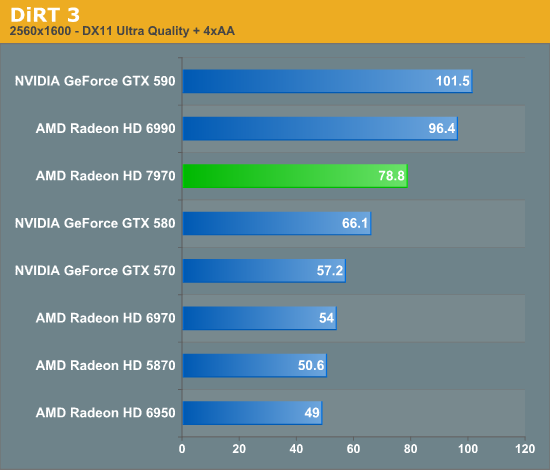
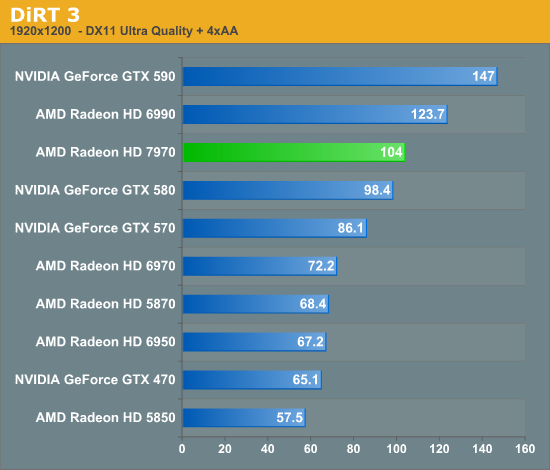
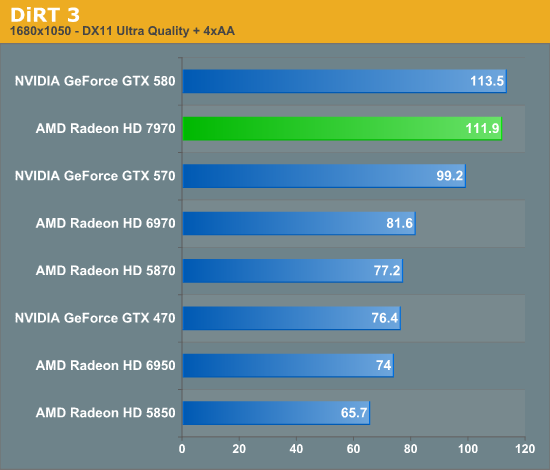
With DiRT 2 NVIDIA often held a slight edge in performance, and due to the reuse of the EGO engine this hasn’t really changed in DiRT 3. As a result the 7970 is still faster than the GTX 580, but not by as much as in other games. At 2560 this manifests itself as a 19% lead, while at 1920 it’s down to 6%, and embarrassingly enough at 1680 the 7970 actually falls behind the GTX 580 by just a hair. DiRT 3 is not particularly shader heavy so that may be part of the reason that the 7970 can’t easily clear the GTX 580 here, but that doesn’t fully explain what we’re seeing. At the end of the day this is all academic since everything north of the GTX 570 can clear 60fps even at 2560, but it would be nice to eventually figure out why NVIDIA does better than average here.
Meanwhile compared to the 6970 the 7970 enjoys one of its bigger leads. Here the 7970 leads by about 45% at 2560 and 1920, and finally falls slightly to 37% at 1680.

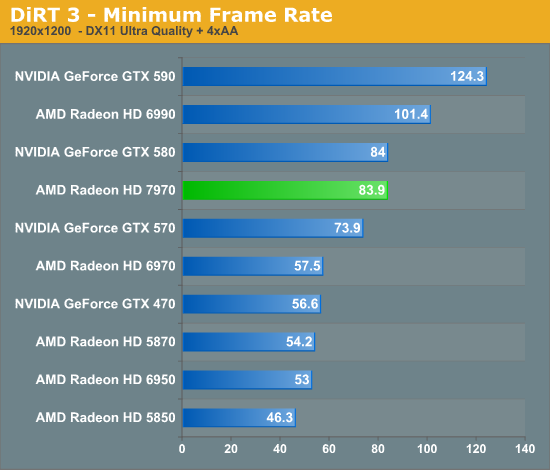
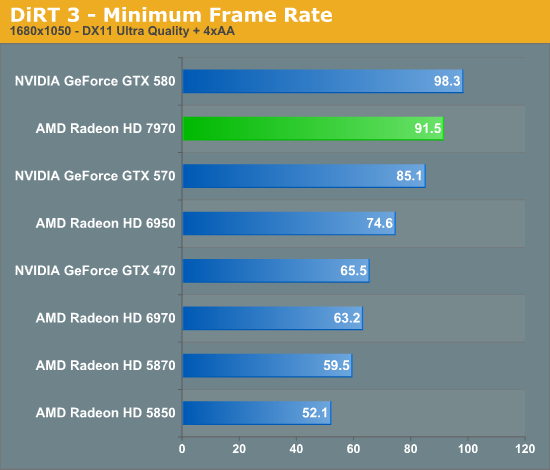
We’ve had a number of requests for more minimum framerates throughout the years, so we’re also going to include the minimum framerates for DiRT 3 as the minimums have proven to be reliably consistent in our benchmarks.
Given that the 7970 was already seeing a smaller than typical lead over the GTX 580, it’s not wholly surprising to see that it fares a bit worse when it comes to minimums. At 2560 its minimum framerate of 64.2fps means that the 7970 will deliver smooth performance every last moment, but at the same time this is only 11% better than the GTX 580. At 1920 this becomes a dead heat between the two cards. Meanwhile compared to the 6970 the 7970 is always about 45% ahead.










292 Comments
View All Comments
Zingam - Thursday, December 22, 2011 - link
And at the time when it is available in D3D. AMD's implementation won't be compatible... :D That's sounds familiar. So will have to wait for another generation to get the things right.Ryan Smith - Thursday, December 22, 2011 - link
As for your question about FP64, it's worth noting that of the FP64 rates AMD listed for GCN, "0" was not explicitly an option. It's quite possible that anything using GCN will have at a minimum 1/16th FP64.Sind - Thursday, December 22, 2011 - link
Excellent review thanks Ryan. Looking forward to see what the 7950 performance and pricing will end up. Also to see what nv has up their sleeves. Although I can't shake the feeling amd is holding back.chizow - Thursday, December 22, 2011 - link
Another great article, I really enjoyed all the state-of-the-industry commentary more than the actual benchmarks and performance numbers.One thing I may have missed was any coverage at all of GCN. Usually you guys have all those block diagrams and arrows explaining the changes in architecture. I know you or Anand did a write-up on GCN awhile ago, but I may have missed the link to it in this article. Or maybe put a quick recap in there with a link to the full write-up.
But with GCN, I guess we can close the book on AMD's past Vec5/VLIW4 archs as compute failures? For years ATI/AMD and their supporters have insisted it was the better compute architecture, and now we're on the 3rd major arch change since unified shaders, while Nvidia has remained remarkably consistent with their simple SP approach. I think the most striking aspect of this consistency is that you can run any CUDA or GPU accelerated apps on GPUs as old as G80, while you even noted you can't even run some of the most popular compute apps on 7970 because of arch-specific customizations.
I also really enjoyed the ISV and driver/support commentary. It sounds like AMD is finally serious about "getting in the game" or whatever they're branding it nowadays, but I have seen them ramp up their efforts with their logo program. I think one important thing for them to focus on is to get into more *quality* games rather than just focusing on getting their logo program into more games. Still, as long as both Nvidia and AMD are working to further the compatibility of their cards without pushing too many vendor-specific features, I think that's a win overall for gamers.
A few other minor things:
1) I believe Nvidia will soon be countering MLAA with a driver-enabled version of their FXAA. While FXAA is available to both AMD and Nvidia if implemented in-game, providing it driver-side will be a pretty big win for Nvidia given how much better performance and quality it offers over AMD's MLAA.
2) When referring to active DP adapter, shouldn't it be DL-DVI? In your blurb it said SL-DVI. Its interesting they went this route with the outputs, but providing the active adapter was definitely a smart move. Also, is there any reason GPU mfgs don't just add additional TMDS transmitters to overcome the 4x limitation? Or is it just a cost issue?
3) The HDMI discussion is a bit fuzzy. HDMI 1.4b specs were just finalized, but haven't been released. Any idea whether or not SI or Kepler will support 1.4b? Biggest concern here is for 120Hz 1080p 3D support.
Again, thoroughly enjoyed reading the article, great job as usual!
Ryan Smith - Thursday, December 22, 2011 - link
Thanks for the kind words.Quick answers:
2) No, it's an active SL-DVI adapter. DL-DVI adapters exist, but are much more expensive and more cumbersome to use because they require an additional power source (usually USB).
As for why you don't see video cards that support more than 2 TMDS-type displays, it's both an engineering and a cost issue. On the engineering side each TMDS source (and thus each supported TMDS display) requires its own clock generator, whereas DisplayPort only requires 1 common clock generator. On the cost side those clock generators cost money to implement, but using TMDS also requires paying royalties to Silicon Image. The royalty is on the order of cents, but AMD and NVIDIA would still rather not pay it.
3) SI will support 1080P 120Hz frame packed S3D.
ericore - Thursday, December 22, 2011 - link
Core Next: It appears AMD is playing catchup to Nvidia's Cuda, but to an extent that halves the potential performance metrics; I see no other reason why they could not have achieved at varying 25-50% improvement in FPS. That is going to cost them, not just for marginally better performance 5-25%, but they are price matching GTX 580 which means less sales though I suppose people who buy 500$ + GPUs buy them no matter what. Though in this case, they may wait to see what Nvidia has to offer.Other New AMD GPUs: Will be releasing in February and April are based on the current architecture, but with two critical differences; smaller node + low power based silicon VS the norm performance based silicon. We will see very similar performance metrics, but the table completely flips around: we will see them, cheaper, much more power efficient and therefore very quiet GPUs; I am excited though I would hate to buy this and see Nvidia deliver where AMD failed.
Thanks Anand, always a pleasure reading your articles.
Angrybird - Thursday, December 22, 2011 - link
any hint on 7950? this card should go head to head with gtx580 when it release. good job for AMD, great review for Ryan!ericore - Thursday, December 22, 2011 - link
I should add with over 4 billion transistors, they've added more than 35% more transistors but only squeeze 5-25% improvement; unacceptable. That is a complete fail in that context relative to advancement in gaming. Too much catchup with Nvidia.Finally - Thursday, December 22, 2011 - link
...that saying? It goes like this:If you don't show up for a race, you lose by default.
Your favourite company lost, so their fanboys may become green of envydia :)
Besides that - I'd never shell out more than 150€ for a petty GPU, so neither company's product would have appealed to me...
piroroadkill - Thursday, December 22, 2011 - link
Wait, catchup? In my eyes, they were already winning. 6950 with dual BIOS, unlock it to 6970.. unbelievable value.. profit??Already has a larger framebuffer than the GTX580, so...